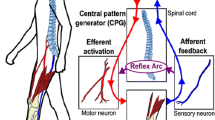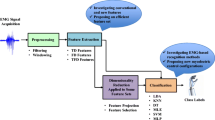Surface EMG (sEMG) signals along with pattern recognition algorithms demonstrate a significant potential to identify and predict human motor activity. We propose a single-channel sEMG signalbased continuous locomotion identification method using a simple classifier. The performance of the proposed method was evaluated for three daily-life locomotion modes on a dataset of 15 subjects. A ranking-based feature selection method was applied to optimize the feature vector. The performance of the proposed method was compared comprehensively with intuitive feature vectors and principle component analysis (PCA). The mean top performances were shown by the Support Vector Machine (SVM), Linear Discriminant Analysis (LDA), and Neural Network (NN) classifiers as 98.65 ± 0.23, 98.42 ± 0.68, and 99.41 ± 0.51%, respectively (P > 0.05). Further, the subjectwise performance of individually trained classifiers (5 subjects) was accessed through the performance indices, namely classification accuracy, precision, sensitivity, specificity, and F-score. The obtained results indicated no significant degradation and difference in the performance among subjects (P > 0.05). The encouraging results of the proposed method justify its possible use for efficient prosthesis control.
Similar content being viewed by others
References
K. Ziegler-Graham, E. J. MacKenzie, P. L. Ephraim, et al., “Estimating the prevalence of limb loss in the United States: 2005 to 2050,” Arch. Phys. Med. Rehabil., 89, No. 3, 422–429 (2008).
M. R. Tucker, J. Olivier, A. Pagel, et al., “Control strategies for active lower extremity prosthetics and orthotics: a review,” J. Neuroeng. Rehabil., 12, 1–29 (2015).
B. Hu, E. Rouse, and L. Hargrove, “Fusion of bilateral lower-limb neuromechanical signals improves prediction of locomotor activities,” Front. Robot. AI, 5, 1–16 (2018).
S. Au, M. Berniker, and H. Herr, “Powered ankle-foot prosthesis to assist level-ground and stair-descent gaits,” Neural Netw., 21, No. 4, 654–666 (2008).
D. A. Winter and H. J. Yack, “EMG profiles during normal human walking: stride-to-stride and inter-subject variability,” Electroencephalogr. Clin. Neurophysiol., 67, No. 5, 402–411 (1987).
D. L. Grimes, “An active multi-mode above knee prosthesis controller,” Ph.D. Thesis, Massachusetts Institute of Technology (1979).
H. A. Varol, F. Sup, and M. Goldfarb, “Multiclass real-time intent recognition of a powered lower limb prosthesis,” IEEE Trans. Biomed. Eng., 57, No. 3, 542–551 (2010).
A. J. Young, A. M. Simon, N. P. Eey, and L. J. Hargrove, “Intent recognition in a powered lower limb prosthesis using time history information,” Ann. Biomed. Eng., 42, No. 3, 631–641 (2014).
B. Chen, E. Zheng, and Q. Wang, “A locomotion intent prediction system based on multi-sensor fusion,” Sensors, 14, 12349–12369 (2014).
A. J. Young, A. M. Simon, and L. J. Hargrove, “A training method for locomotion mode prediction using powered lower limb prostheses,” IEEE Trans. Neural Syst. Rehabil. Eng., 22, No. 3, 671–677 (2014).
B. Chen, X. Wang, Y. Huang, et al., “A foot-wearable interface for locomotion mode recognition based on discrete contact force distribution,” Mechatronics, 32, December, 12–21 (2015).
K. Yuan, Q. Wang, and L. Wang, “Fuzzy-logic-based terrain identification with multisensor fusion for transtibial amputees,” IEEE Trans. Mechatronics, 20, No. 2, 618-630 (2015).
A. Aggarwal, R. Gupta, and R. Agarwal, “Design and development of integrated insole system for gait analysis,” in: Eleventh International Conference on Contemporary Computing (IC3) (2018), pp. 1–5.
H. Huang, F. Zhang, L. J. Hargrove, et al., “Continuous locomotion-mode identification for prosthetic legs based on neuromuscular – mechanical fusion,” IEEE Trans. Biomed. Eng., 58, No. 10, 2867–2875 (2011).
M. E. Joshi, D. Hahn, D. Joshi, et al., “Terrain and direction classification of locomotion transitions using neuromuscular and mechanical input,” Ann. Biomed. Eng., 44, No. 4, 1275–1284 (2016).
J. A. Spanias, A. M. Simon, K. A. Ingraham, and L. J. Hargrove, “Effect of additional mechanical sensor data on an EMG - based pattern recognition system for a powered leg prosthesis,” in: IEEE EMBS Conference on Neural Engineering (2015), pp. 22–24.
A. J. Young, T. A. Kuiken, and L. J. Hargrove, “Analysis of using EMG and mechanical sensors to enhance intent recognition in powered lower limb prostheses,” J. Neural Eng., 11, No. 5, 1–12 (2014).
F. Zhang and H. Huang, “Source selection for realtime user intent recognition toward volitional control of artificial legs,” IEEE J. Biomed. Heal. Inform., 17, No. 5, 907–914 (2013).
J. D. Miller, M. S. Beazer, and M. E. Hahn, “Myoelectric walking mode classification for transtibial amputees,” IEEE Trans. Biomed. Eng., 60, No. 10, 2745–2750 (2013).
L. Du, F. Zhang, M. Liu, and H. Huang, “Toward design of an environment-aware adaptive locomotion-moderecognition system,” IEEE Trans. Biomed. Eng., 59, No. 10, 2716–2725 (2012).
X. Zhang, D. Wang, Q. Yang, and H. Huang, “An Automatic and user-driven training method for locomotion mode recognition for artificial leg control,” in: 34th Annual International Conference of the IEEE EMBS (2012), pp. 6116–6119.
M. T. Farrell and H. Herr, “A method to determine the optimal features for control of a powered lower-limb prostheses,” in: 33rd Annual International Conference of the IEEE EMBS (2011), pp. 6041–6046.
S. Pati, D. Joshi, and A. Mishra, “Locomotion classification using EMG signal,” in: 2010 International Conference on Information and Emerging Technologies (2010), pp. 1–6.
H. Huang, F. Zhang, Y. L. Sun, and H. He, “Design of a robust EMG sensing interface for pattern classification,” J. Neural Eng., 7, No. 5, 056005 (2010).
R. Gupta and R. Agarwal, “Continuous human locomotion identification for lower limb prosthesis control,” CSI Trans. ICT, 6, No. 1, 17–31 (2017).
SENIAM, “Sensors location: Recommendations for sensor locations on individual muscles,” 2016. [Online available]: http://seniam.org/sensor_location.htm.
R. Gupta and R. Agarwal, “Electromyographic signal driven continuous locomotion mode identification module design for lower limb prosthesis control,” Arab. J. Sci. Eng., 43, No. 12, 7817–7835 (2018).
M. Sokolova and G. Lapalme, “A systematic analysis of performance measures for classification tasks,” Inf. Process. Manag., 45, No. 4, 427–437 (2009).
Q. J. Song, H. Y. Jiang, and J. Liu, “Feature selection based on FDA and F-score for multi-class classification,” Expert Syst. Appl., 81, 22–27 (2017).
I. S. Dhindsa, R. Agarwal, and H. S. Ryait, “Principal component analysis-based muscle identification for myoelectric-controlled exoskeleton knee,” J. Appl. Stat., 44, No. 10, 1707–1720 (2016).
G. Chandrashekar and F. Sahin, “A survey on feature selection methods,” Comput. Electr. Eng., 40, No. 1, 16–28 (2014).
G. S. Murley, H. B. Menz, and K. B. Landorf, “Foot posture influences the electromyographic activity of selected lower limb muscles during gait,” J. Foot Ankle Res., 2, No. 1, 1–9 (2009).
Author information
Authors and Affiliations
Corresponding author
Rights and permissions
About this article
Cite this article
Gupta, R., Agarwal, R. Single Muscle Surface EMGs Locomotion Identification Module for Prosthesis Control. Neurophysiology 51, 191–208 (2019). https://doi.org/10.1007/s11062-019-09812-w
Received:
Published:
Issue Date:
DOI: https://doi.org/10.1007/s11062-019-09812-w




